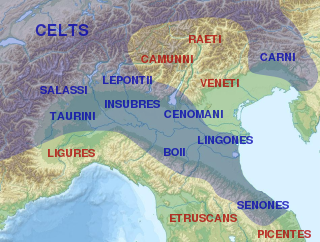Related Research Articles

The Taurini were a Celto-Ligurian tribe dwelling in the upper valley of the river Po, around present-day Turin, during the Iron Age and the Roman period.
The Deciates (Δεκιήταις) were a Ligurian tribe dwelling near on the Mediterranean coast, around present-day Antibes, during the Iron Age and the Roman era.
The Oxybii or Oxubii were a Celto-Ligurian tribe dwelling on the Mediterranean coast during the Iron Age and the Roman period.
The Salyes or Salluvii were an ancient Celto-Ligurian people dwelling between the Durance river and the Greek colony of Massalia during the Iron Age. Although earlier writers called them 'Ligurian', Strabo used the denomination 'Celto-ligurian', and a Celtic influence is noticeable in their religion, which centred on the cult of the tête coupée. In fact, the Salyes were most likely at the head of a political and military confederation that united both Gallic and Ligurian tribes.
The Medulli were a Gallic tribe dwelling in the upper valley of Maurienne, around present-day Modane (Savoie), during the Iron Age and Roman period.
The Marici were a Celto-Ligurian tribe dwelling around present-day Pavia (Lombardy) during the Iron Age.
The Ceutrones were a Gallic tribe dwelling in the Tarantaise Valley, in modern Savoie, during the Iron Age and Roman period.
The Tricastini were a small Gallic tribe dwelling in the modern Tricastin region, near present-day Saint-Paul-Trois-Châteaux, during the Iron Age and the Roman period.
The Veliocasses were a Belgic or Gallic tribe of the La Tène and Roman periods, dwelling in the south of modern Seine-Maritime and in the north of Eure.

The Vindelici were a Gallic people dwelling around present-day Augsburg (Bavaria) during the Iron Age and the Roman period.
The Vediantii were a Celto-Ligurian tribe dwelling on the Mediterranean coast, near present-day Nice, during the Iron Age and the Roman period.
The Intimilii or Intemelii were a Ligurian tribe dwelling on the Mediterranean coast, around present-day Ventimiglia, during the Iron Age and the Roman period.
The Epanterii or Epanterii Montani were a small Ligurian tribe dwelling in the lower Alps, near the Mediterranean coast, during the Iron Age.
The Nemeturii or Nemeturi were a Gallic tribe dwelling in the Alpes Maritimae during the Iron Age.
The Eguiturii or Eguituri were a Celto-Ligurian tribe dwelling in the Alpes Maritimae during the Iron Age.
The Vergunni were a Gallic tribe dwelling in the valley of the Riou, near the Verdon river, during the Iron Age.
The Sogionti or Sogiontii were a Gallic tribe dwelling around present-day Sisteron during the Iron Age.
The Rucinates or Runicates were a Gallic tribe dwelling in near the confluence of the Isar and Danube rivers during the Roman period.
The Gallitae were a Gallic tribe dwelling in the upper valley of the Bléone river (Alpes-de-Haute-Provence) during the Iron Age.
The Ligauni were a Celto-Ligurian tribe dwelling near the Mediterranean coast during the Iron Age and the Roman period.
References
- ↑ Livy. Ab Urbe Condita Libri, 28:46, 30:19, 31:2, 39:32, 40:25, 40:28, 40:34, 40:41.
- ↑ Strabo. Geōgraphiká, 4:6:1.
- ↑ Pliny. Naturalis Historia, 3:46.
- ↑ Falileyev 2010, s.v. Ingauni and Album Ingaunum.
- ↑ de Bernardo Stempel 2006, p. 46.
- ↑ Giannattasio 2007, p. 136.
- ↑ Barruol 1969, p. 368.
- 1 2 Talbert 2000, Map 16: Col. Forum Iulii-Albingaunum.
- ↑ Dyson 1985, p. 92.
- ↑ Dyson 1985, pp. 96–97.
- ↑ Livy. Ab Urbe Condita Libri, 31:2.
- 1 2 Dyson 1985, pp. 102–104.
- ↑ Dyson 1985, p. 103.
Primary sources
- Livy (2019). History of Rome. Loeb Classical Library. Translated by Yardley, J. C. Harvard University Press. ISBN 978-0674992566.
- Pliny (1938). Natural History. Loeb Classical Library. Translated by Rackham, H. Harvard University Press. ISBN 9780674993648.
- Strabo (1923). Geography. Loeb Classical Library. Translated by Jones, Horace L. Harvard University Press. ISBN 978-0674990562.
Bibliography
- Barruol, Guy (1969). Les Peuples préromains du Sud-Est de la Gaule: étude de géographie historique. E. de Boccard. OCLC 3279201.
- de Bernardo Stempel, Patrizia (2006). "From Ligury to Spain: Unaccented *yo > (y)e in Narbonensic votives ('gaulish' DEKANTEM), Hispanic coins ('iberian' -(sk)en) and some theonyms". Palaeohispanica. 6: 45–58. ISSN 1578-5386.
- Dyson, Stephen L. (1985). The Creation of the Roman Frontier. Princeton University Press. ISBN 978-1-4008-5489-9.
- Giannattasio, Bianca Maria (2007). I liguri e la Liguria: storia e archeologia di un territorio prima della conquista romana. Longanesi. ISBN 978-88-304-2123-3.
- Falileyev, Alexander (2010). Dictionary of Continental Celtic Place-names: A Celtic Companion to the Barrington Atlas of the Greek and Roman World. CMCS. ISBN 978-0955718236.
- Talbert, Richard J. A. (2000). Barrington Atlas of the Greek and Roman World. Princeton University Press. ISBN 978-0691031699.
